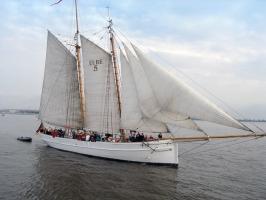 On Saturday, the restored pilot schooner No. 5 Elbe sank following a collision with a containership on its namesake river at Stade, Germany. The 43 people aboard the 1883 built schooner were rescued almost immediately thanks to a quick response from five rescue boats which happened to be in the area on another distress call. Six adults and two children were injured, one seriously, in the collision.
On Saturday, the restored pilot schooner No. 5 Elbe sank following a collision with a containership on its namesake river at Stade, Germany. The 43 people aboard the 1883 built schooner were rescued almost immediately thanks to a quick response from five rescue boats which happened to be in the area on another distress call. Six adults and two children were injured, one seriously, in the collision.
An investigation will determine the cause of the collision between the pilot schooner and the Cyprus-flagged container ship, Astrosprinter. Current reports suggest that the schooner turned across the fairway, directly into the path of the container ship. The Guardian describes the course change as a “failed tack” by the gaff-rigged schooner. Other reports suggest that the container ship was outside the channel lane.
The No. 5 Elbe was built by Gustav Junge in 1883. It served for 41 years as a pilot schooner before it was sold in the 1920s to American journalist Warwick Tompkins. Tompkins made several transatlantic passages with the renamed Wander Bird before he moved to the San Francisco Bay Area. In the 1930s, the Tompkins family sailed the Wander Bird around Cape Horn — going the “wrong way” from east to west. He later chartered the boat for trips to the South Sea islands.
In the late 1960s, the schooner was acquired by Harold Sommer in the late ‘60s and underwent an extensive restoration by a cast of waterfront characters and legends, including Spike Africa, John Linderman and actor/sailor/author Sterling Hayden. According to Latitude 38, the project was deemed by the Smithsonian Museum to be the most significant vessel restoration done by a private individual in the US in the 1990s.
In the 1990s, the schooner was acquired by new owners and allowed to deteriorate. In 2002, she was rescued by the Hamburg Maritime Foundation and returned to Hamburg for restoration. It is unclear whether the schooner can be salvaged. The 85-ft length on deck schooner completed a $1.7m refit in a Danish shipyard only last month.
Thanks to Alaric Bond, Virginia Jones, Robert Kennedy, Roger Eastman, Jean-Pierre Declemy and David Rye for contributing to this post.

Ship sunk!
Newly restored historic sailing ship crashes and sinks days after relaunch
https://www.cnn.com/2019/06/10/europe/hamburg-boat-crash-scli-grm-intl/index.html
Scariest pic here:
https://www.maritime-executive.com/article/photos-hamburg-s-oldest-wooden-ship-collides-with-container-feeder
Normally, the smaller ship gives right of-way, but not in this case.
Can’t expect a larger ship to move or stop.
Sailboat is at fault!
This is a very unfortunate incident particularly after the major refit. The “Astrosprinter” no doubt had an Elbe pilot on board. I ran regularly to the Elbe during several Summers from Irish ports and it is a busy place. I further understand that an investigation will take place so one is surprised that once again Phil, a regular commenter, is on the ball and has the answer stating the sailboat is at fault. Having investigated many maritime incidents one could have used his crystal ball!!
Good Watch.
Such a sad ending for a boat with magnificent lines
The Sinking of Wander Bird
By mgrant on June 12, 2019 at 4:00 AM
Early reports differ as to the cause of the accident. One report notes a ‘failed tack’; another that the Cyprus-flagged Astrosprinter was “out of its shipping lane.” Maritime law puts the burden on smaller vessels to keep clear of large ones, but we don’t know if the rules of the road are different in Germany (or the Elbe), how fast each vessel was going, or, ultimately, which one was at fault. Investigations are underway and we’ll post more information on ‘Lectronic Latitude as we get it.
https://blog.sfgate.com/latitude38/2019/06/12/the-sinking-of-wander-bird/
This so sickening. First problem: I noticed from the video is that the ship has a tiller assisted by block and tackles which several people were struggling with. Wanderbird had wheel steering; it is too big a vessel for a tiller. Wheels are geared.
This looks like a repeat of the Andrea Doria/Stockholm collision in in which the two ships approach in a manner that the evasive tactic is not obvious and a wrong move by either makes matters worse. So bilateral communication is essential This calamity in 1954 resulted in the requirement for all ships to monitor a dedicated bridge to bridge channel, 13 . In this situation communication between the two would have prevented it-if they both spoke German or English(the international language). In the US , I believe there has to be an English speaker on the bridge.
From the video it is apparent that the schooner was allowed to get into a position “in extremis”; that is beyond the point of escape. It is always important to make a maneuvering decision way before that point. This is the cause of many accidents.